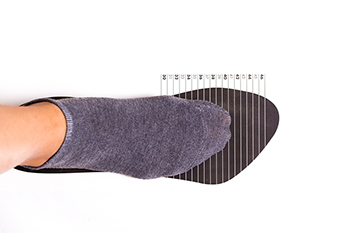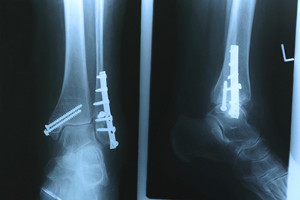Items filtered by date: March 2023
Causes of Bruised Toenails

Bruised toenails, also termed subungual hematomas, are characterized by a darkened nail. This is caused by bleeding under the toenail, which can become painful. Bruised toenails are common among ballet dancers, especially those who dance on pointe. This action places a great deal of force on the toenail and often causes the nail to pull away from the bed. Bruised toenails can also result from dropping a heavy object on the toe. To relieve the pressure of a bruised toenail, it may be necessary to drain the blood underneath the nail. A podiatrist can carry out this procedure by drilling a tiny hole in the nail to release the blood and swabbing it with alcohol to avoid infection. Resting the foot for a few days is recommended to give the nail bed a chance to heal. To avoid future toe bruising, it is wise to keep toenails trimmed short. For help with bruised toenails, it is suggested that you see a podiatrist for safe treatment.
Toe pain can disrupt your daily activities. If you have any concerns, contact Jim Maxka, DPM of South Penn Foot & Ankle Associates. Our doctor can provide the care you need to keep you pain-free and on your feet.
What Causes Toe Pain?
Most severe toe pain is caused due to a sports injury, trauma from dropping something heavy on the toe, or bumping into something rigid. Other problems can develop over time for various reasons.
Toe pain can be caused by one or more ailments. The most common include:
- Trauma
- Sports injury
- Wearing shoes that are too tight
- Arthritis
- Gout
- Corns and calluses
- Hammertoe
- Bunions
- Blisters
- Ingrown toenails
- Sprains
- Fractures (broken bones)
- Dislocations
When to See a Podiatrist
- Severe pain
- Persistent pain that lasts more than a week
- Signs of infection
- Continued swelling
- Pain that prevents walking
Diagnosis
In many cases the cause of toe pain is obvious, but in others, a podiatrist may want to use more advanced methods to determine the problem. These can range from simple visual inspections and sensation tests to X-rays and MRI scans. Prior medical history, family medical history, and any recent physical traumatic events will all be taken into consideration for a proper diagnosis.
Treatment
Treatments for toe pain and injuries vary and may include shoe inserts, padding, taping, medicines, injections, and in some cases, surgery. If you believe that you have broken a toe, please see a podiatrist as soon as possible.
If you have any questions please feel free to contact our office located in Hanover, PA . We offer the newest diagnostic tools and technology to treat your foot and ankle needs.
Shopping for Shoes

When you are ready to buy new shoes, it is important to keep function and comfort in mind. Fashion should be secondary. Tips for helping to pick out the right shoes for you include shopping for shoes later in the day as the feet expand as the day wears on, measuring your feet, and trusting your comfort level at the time of trying on the shoes. Well-fitting shoes will not need a break-in period to feel comfortable. Furthermore, bring the foot coverings you plan to wear with the new shoes to the store, make sure there is at least a half-inch between the longest toe and the end of the shoe, and pay attention to the width as well as the length of the shoes. If you have additional questions about purchasing the right shoes for your feet, it is suggested that you consult with a podiatrist who can best direct you.
Getting the right shoe size is an important part of proper foot health. Seek the assistance of Jim Maxka, DPM from South Penn Foot & Ankle Associates. Our doctor will provide the care you need to keep you pain-free and on your feet.
Getting the Right Shoe Size
There are many people who wear shoes that are the incorrect size, negatively affecting their feet and posture. Selecting the right shoes is not a difficult process, so long as you keep several things in mind when it comes to choosing the right pair.
- When visiting the shoe store, use the tools available to measure your foot.
- Be sure there is ‘wiggle room’. There should be about an inch between your toes and the tip of your shoes.
- Do not always assume you are the same size, as manufacturers run differently.
- Purchase shoes later in the day, as your feet swell as the day progresses.
- If a shoe is not comfortable, it is not suitable. Most shoes can’t be ‘broken in’, and comfort should be the ultimate goal when it comes to choosing the right pair of shoes
As our feet hold our body weight and keep us moving, it is important to treat them right. Picking the right pair of shoes can provide your feet comfort and mobility without pain.
If you have any questions, please feel free to contact our office located in Hanover, PA . We offer the newest diagnostic and treatment technologies for all your foot care needs.
Is Podiatry Right for Me?

People who have foot or ankle pain are typically treated by a podiatrist. These are doctors that specialize in ailments that occur in these parts of the body, and many podiatrists can perform surgery. There are several years of mandatory education required to become a Doctor of Podiatric Medicine, or DPM. This begins with obtaining a bachelor's degree, followed by enrolling in podiatry school. Oftentimes podiatrists obtain a Bachelor of Science degree. Medical school will focus on the feet and ankles, and it is helpful to pursue volunteer work and internships. This is a four-year program, and education continues with a residency program, totaling seven years after obtaining a BS. A residency involves working in a hospital or clinic setting, which must be completed before working independently. If you are interested in pursuing podiatry as a career, please plan to spend some time conferring with this type of doctor who can answer any questions you may have.
If you are experiencing pain in the feet or ankles, don’t join the stubborn majority refusing treatment. Feel free to contact Jim Maxka, DPM from South Penn Foot & Ankle Associates. Our doctor can provide the care you need to keep you pain-free and on your feet.
What Is a Podiatrist?
Someone would seek the care of a podiatrist if they have suffered a foot injury or have common foot ailments such as heal spurs, bunions, arch problems, deformities, ingrown toenails, corns, foot and ankle problems, etc.
Podiatric Treatment
A podiatrist will treat the problematic areas of the feet, ankle or lower leg by prescribing the following:
- Physical therapy
- Drugs
- Orthotic inserts or soles
- Surgery on lower extremity fractures
A common podiatric procedure a podiatrist will use is a scanner or force plate which will allow the podiatrist to know the designs of orthotics. Patients are then told to follow a series of tasks to complete the treatment. The computer will scan the foot a see which areas show weight distribution and pressure points. The podiatrist will read the analysis and then determine which treatment plans are available.
If you have any questions please feel free to contact our office located in Hanover, PA . We offer the newest diagnostic and treatment technologies for all your foot and ankle needs.
It's Time for Beautiful Feet
3 Parts of the Ankle

A broken ankle is a common injury. There are various reasons why this can occur, including enduring a fall, having excessive pressure placed on the ankle, or from ligament damage. The tibia, fibula, and talus are the common areas of the ankle that can become fractured. If the ankle is suddenly twisted, or a heavy object falls on it, these may be additional reasons why ankle bones can break. Symptoms that are associated with this condition often include immediate pain, and there may be extensive swelling. Many patients are unable to walk with a broken ankle, and an X-ray can be taken to determine its severity. Recovery time can take a few weeks or even months, and patients may have a walking boot or cast on their foot during the healing process. This is helpful in stabilizing the foot, and it can provide ease in completing daily activities. If you have broken your ankle, it is suggested that you consult with a podiatrist as quickly as possible who can properly diagnose and choose the correct treatment method for you.
Broken ankles need immediate treatment. If you are seeking treatment, contact Jim Maxka, DPM from South Penn Foot & Ankle Associates. Our doctor can provide the care you need to keep you pain-free and on your feet.
Broken Ankles
A broken ankle is experienced when a person fractures their tibia or fibula in the lower leg and ankle area. Both of these bones are attached at the bottom of the leg and combine to form what we know to be our ankle.
When a physician is referring to a break of the ankle, he or she is usually referring to a break in the area where the tibia and fibula are joined to create our ankle joint. Ankles are more prone to fractures because the ankle is an area that suffers a lot of pressure and stress. There are some obvious signs when a person experiences a fractured ankle, and the following symptoms may be present.
Symptoms of a Fractured Ankle
- Excessive pain when the area is touched or when any pressure is placed on the ankle
- Swelling around the area
- Bruising of the area
- Area appears to be deformed
If you suspect an ankle fracture, it is recommended to seek treatment as soon as possible. The sooner you have your podiatrist diagnose the fracture, the quicker you’ll be on the way towards recovery.
If you have any questions, please feel free to contact our office located in Hanover, PA . We offer the newest diagnostic and treatment technologies for all your foot care needs.

